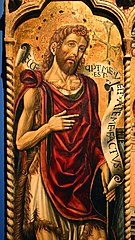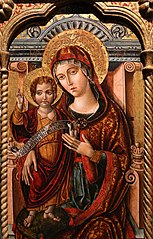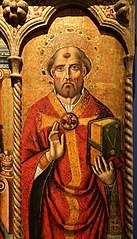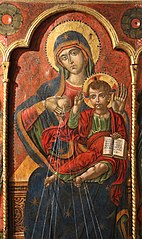Michele Greco da Valona
Michele Greco da Valona | |
|---|---|
 Madonna col Bambino e Santi(Madonna and Child with Saints) | |
| Born | 15th Century Vlorë, Albania |
| Died | 16th Century |
| Nationality | Greek |
| Known for | Painting |
| Movement | Italian Renaissance |
Michele Greco da Valona (Italian for 'Michael the Greek from Vlora') was a 15th/16th-century Greek painter from Vlorë, Albania. Michele represented the Adriatic renaissance. His art was similar to the style of Nicolaus Filantropinó, Fra Angelico, Paolo Uccello, Carlo Crivelli and Vincenzo de Rogata. Several of his works have survived, most notable of which is a controversial triptych featuring the Virgin Mary breastfeeding the people.[1][2][3]
History[]
Not much is known about his life. Michele was born in Vlorë, Albania, as a member of the Greek community in the city. Many Greeks migrated to Italy after the fall of the Byzantine Empire. He signed his work Op. Michalis Greci De La Velona. The signature identifies his origin as Greek. Italian archives indicated Michele was paid to travel to Constantinople on May 10 to find out Mehmed the Conqueror's military plans. He relayed the information to Alfonso II of Naples who won a decisive victory at the Battle of Otranto. Michele was active in Abruzzo and Molise. He did not follow the same migratory pattern as other Greek refugees who settled in Venice or Crete. He is one of the few artists to have traveled all over Italy.[4]

He was trained as a Byzantine master. His early work resembled Greek master Nikolaos Philanthropinos. As Michele's career progressed he sheds his maniera greca and exhibits a more sophisticated Venetian style. This was very common among Greek painters. The Cretan and Heptaneses school was heavily influenced by the Venetian style. Michele's work is unique because it represents the Adriatic renaissance. Unlike his contemporaries, his work resembled Carlo Crivelli. There is also evidence he was influenced by Vincenzo de Rogata. The evidence is in the triptych from the San Bernardino coven in Salerno.[5]
The painter's first work is a triptych he painted in 1505. It features the Madonna and Child between Saints John the Baptist and Adam, with a Pietà. The work was done for the church of Santa Maria Maggiore in Guglionesi and is now in the Aquila museum. His signature poem at the bottom of the triptych provides some information about the artist. He was a Greek from Vlorë, Albania. Many Greek artists added the city where they completed their works and where they were from in the signature poem. One example was Greek painter Efstathios Karousos active in Naples. The name Antonio Barono also appears at the bottom of the piece. There are also Greek inscriptions: ΜΡ ΘΥ (short for ΜΗΤΗΡ ΘΕΟΥ, "Mother of God").[6]
There are two other paintings in Guglionesi. One is dated 1505 and the other 1508. The earlier painting is the Madonna delle Grazie between Saints Rocco and Sebastiano. This work is very controversial because the Virgin is feeding breast milk to the people. Breast milk is reigning from the heavens. The painting has been featured in the Italian news on countless occasions. The final work dated 1508, featured Madonna between Saints Peter and Paul His artwork is part of the national heritage of Italy, Greece, and Albania.[7]
Gallery[]

Close Up of John the Baptist

Close Up of Virgin and Child

Clost Up of Saint Adam
Close up of Holy Shower
References[]
| Wikimedia Commons has media related to Michele Greco da Valona. |
- ^ Abbate, Francesco (1997). History of Art in Southern Italy Volume 3. Rome, Italy: Progetti Donzelli. p. 366. ISBN 9788879896535.
- ^ Rosa, Lucia Gualdo (1982). The humanists and the Otranto War texts of the fifteenth and sixteenth centuries. Bari, Italy: Edizioni Dedalo. pp. 95–96. ISBN 9788822060051.
- ^ Hatzidakis & Drakopoulou 1997, p. 192.
- ^ Abbate, 1997, p. 366
- ^ Abbate, 1997, p. 366
- ^ Abbate, 1997, p. 366
- ^ Abbate, 1997, p. 366
Bibliography[]
- Hatzidakis, Manolis; Drakopoulou, Evgenia (1997). Έλληνες Ζωγράφοι μετά την Άλωση (1450-1830). Τόμος 2: Καβαλλάρος - Ψαθόπουλος [Greek Painters after the Fall of Constantinople (1450-1830). Volume 2: Kavallaros - Psathopoulos]. Athens: Center for Modern Greek Studies, National Research Foundation. ISBN 960-7916-00-X.
- Greek icon painters
- Venetian Greeks
- People from Vlorë
- Italian people of Greek descent
- 16th-century Greek painters
- 15th-century Greek painters
- 16th-century Albanian people
- 15th-century Albanian people



